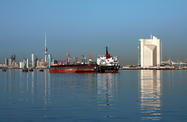Efforts to transform Kuwait’s logistics infrastructure are gathering pace following the announcement that the first phase of the $1.2bn Mubarak Al Kabir port development is on track for completion in the second quarter of 2014.
The port, which will have an initial annual cargo-handling capacity of 1.8m containers, forms a key part of Kuwait’s bid to accommodate growing domestic demand and build a reputation as a trans-shipment centre.
However, while Kuwait’s plans to expand its freight-handling facilities are moving ahead, the country will have to vie for business with its neighbours in what is fast becoming an increasingly competitive regional market.
Still in the early stages of development, the Mubarak Al Kabir facility is being built on Boubyan Island, located near the Iraqi port of Umm Qasr. A briefing provided in October by URS, the engineering and technical consultants overseeing the development, said that much of the early work on the port was on, or ahead of schedule, with more than half the initial stage of the project completed. According to URS, the facility will be handling cargo well before the final work is completed in 2020.
The port is earmarked to become one of Kuwait’s major freight-handling hubs, helping to ease the load on existing facilities at the ports of Shuaiba and Shuwaikh. However, despite plans for it to be equipped with advanced technology and cargo-handling equipment, the facility may meet other challenges.
Observers have pointed out that moves by Kuwait’s neighbours to pump investment into extensive maritime infrastructure programmes of their own could leave Mubarak Al Kabir struggling to edge the competition in the country’s drive to become a regional logistics centre.
“Kuwait’s strategic location, with access to Saudi Arabia, Iraq and Iran, makes it a natural transit and transport hub for the Northern Gulf, but with neighbouring nations working on their own infrastructure upgrades, the market is becomingly increasingly competitive,” Chris Hayman, the chairman of maritime research firm Seatrade, said.
Speaking in mid-November, Hayman said that while the port would provide a significant boost for Kuwait’s logistics sector, its contribution to the economy would be considerably improved if, as has been proposed, the Boubyan Island facility is linked to the planned GCC rail network, which is earmarked for completion before the end of the decade.
Kuwait plans to lay 340 miles of broad-gauge rail, which will connect into the Saudi section and continue on through to the rest of the grid. A proposal has also been made for the northern end of the line to be extended to the border with Iraq, linking into its main lines.
While the extension would raise Mubarak Al Kabir’s trans-shipment capacity to its northern neighbour, the proposal has been caught up in Iraq’s long-standing opposition to the port project itself.
Boubyan’s location on the narrow Khawr Abdullah waterway, which also provides access to Iraq’s ports, prompted Baghdad to accuse Kuwait of attempting to suffocate its shipping trade and cutting off what it regarded as its territorial waters. Concerns were raised that the development could restrict shipping access to Iraq’s ports to the north and lure away clients, despite Kuwait’s assurances that the Boubyan Island project would not harm Iraqi interests.
The controversial issue has died down in recent months following a series of heated exchanges in 2011. However, its sensitivity may make future maritime logistics cooperation between the two countries something of a challenge.
In an effort to allay concerns, Rabah Al Rabah, the director general of the Kuwait Chamber of Commerce and Industry (KCCI), told Iraqi journalists in early November that Mubarak Al Kabir could boost cross-border trade and investment. He said Kuwait was keen to develop trade relations with Iraq, although he acknowledged that for this to happen, more needed to be done to improve sea and land access points.
Kuwait will be keen to tie in Mubarak Al Kabir’s completion with the development of other major transport infrastructure projects as it looks to strengthen interconnectivity with both domestic and regional logistics networks. By establishing its credentials early, the port will be well placed to compete with others in the region.

